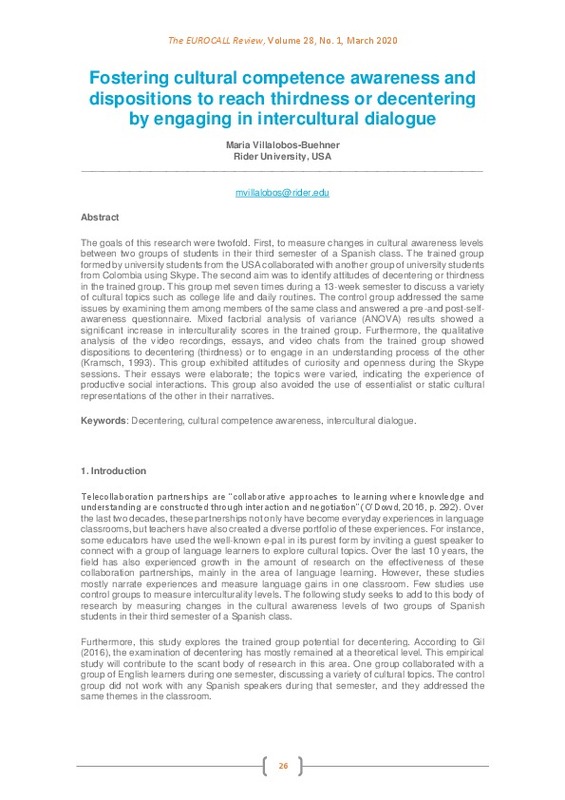Angelova, M., & Zhao, Y. (2014). Using an online collaborative project between American and Chinese students to develop ESL teaching skills, cross-cultural awareness and language skills. Computer Assisted Language Learning, 29(1). https://doi.org/10.1080/09588221.2014.907320
Byram, M. (1997). Teaching and assessing intercultural communicative competence. Clevedon, UK: Multilingual Matters.
Byram, M., Gribkova, B., & Starkey, H. (2002). Developing and intercultural dimension in language teaching. A practical introduction for teachers. Council of Europe, Strasbourg.
[+]
Angelova, M., & Zhao, Y. (2014). Using an online collaborative project between American and Chinese students to develop ESL teaching skills, cross-cultural awareness and language skills. Computer Assisted Language Learning, 29(1). https://doi.org/10.1080/09588221.2014.907320
Byram, M. (1997). Teaching and assessing intercultural communicative competence. Clevedon, UK: Multilingual Matters.
Byram, M., Gribkova, B., & Starkey, H. (2002). Developing and intercultural dimension in language teaching. A practical introduction for teachers. Council of Europe, Strasbourg.
Çiftçi, E.Y., & Savaş, P. (2017). The role of telecollaboration in language and intercultural learning: A synthesis of studies published between 2010 and 2015. ReCALL, 30(3). https://doi.org/10.1017/S0958344017000313
Dugartsyrenova, V.A., & Sardegna, V.G. (2018). Raising intercultural awareness through voicebased telecollaboration: perceptions, uses, and recommendations,Innovation in Language Learning and Teaching, 13(3). https://doi.org/10.1080/17501229.2018.1533017
Gil, G. (2016). Third places and the interactive construction of interculturality in the English as foreign/additional language classroom. Acta Scientiarum. Language and Culture, 38(4), 337- 346. https://doi.org/10.4025/actascilangcult.v38i4.28674
Helm, F., Guth, S., & Farrag, M. (2012). Promoting dialogue or hegemonic practice? Power issues in telecollaboration. Language Learning & Technology, 16(2), 103-127. Retrieved from http://llt.msu.edu/issues/june2012/helmguthfarrah.pdf
Kramsch, C. (1993). Context and Culture in Language Teaching. Oxford, UK: Oxford University Press.
López-Rocha, S. (2016). Intercultural communicative competence: creating awareness and promoting skills in the language classroom. In C. Goria, O. Speicher, & S. Stollhans (Eds), Innovative language teaching and learning at university: enhancing participation and collaboration (pp. 105-111). Dublin: Research-publishing.net. https://doi.org/10.14705/rpnet.2016.000411
O'Dowd, R. (2003). Understanding the "other side": Intercultural learning in a Spanish-English e-mail exchange. Language Learning & Technology, 7(2), 118-144. DOI: 10125/25202
O'Rourke, B. (2007). Models of telecollaboration (1): E(tandem). In R. O'Dowd (Ed.), Online intercultural exchange: An introduction for foreign language teachers (pp. 41-62). Clevedon, UK: Multilingual Matters.
Schenker, T. (2012). Intercultural Competence and Cultural Learning through Telecollaboration. Calico, 29(3), 449-470. https://www.jstor.org/stable/10.2307/calicojournal.29.3.449
Western, Center for Research and Education on Violence Against Women and Children (2017). Cultural competence self-assessment checklist. Retrieved from: http://rapworkers.com/wp-content/uploads/2017/08/cultural-competence-selfassessmentchecklist-1.pdf
[-]









